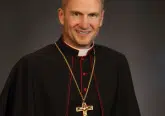Change is coming: The Roman Missal
Wednesday, April 7, 2010
ARCHDIOCESE — It’s been 25 years since the last time a new edition of the Roman Missal was implemented, and as anticipation of the new missal grows, so do questions. Why is this being done? When will it take effect? How do we prepare for it? And what exactly are these changes we’ve been hearing about?
The changes to the language of the Mass were initiated in 2002 when Pope John Paul II issued a new edition of the Roman Missal in Latin. The anticipated date for the introduction of the new missal in the United States is Advent of 2011, 18 months from now. But it’s important that Catholics begin to talk about it now.
In late January the Vatican Congregation for Divine Worship and the Sacraments was in the final stages of reviewing the last sections of the translation before issuing its recognitio, or approval. Once the Vatican approval is received there will be a period of a year or possibly more to implement the Roman Missal. Each conference of bishops will determine the date and method of implementation.
 |
| Shown are pages from the new Roman Missal issued by Pope John Paul II in Latin in 2002. The new English translation of the missal is awaiting final approval by the Vatican. (CNS photo/Nancy Wiechec) |
But before that can happen, priests and people must be involved in a “two-tiered catechetical process” that starts with “general and broad” discussions of such issues as the “nature of the Mass, how it builds up the church and how we encounter Christ,” said Father Rick Hilgartner, associate director of the U.S. bishops’ Secretariat of Divine Worship.
“Some people want to jump right to conversations about the texts” themselves, without the proper context and background, he added. But some of the liturgical texts that have been translated date to the fourth century and “were not crafted in the 21st-century American sound-bite culture” that communicates in “short, simple statements,” Father Hilgartner said.
He said those who have criticized the new liturgical language as out of touch with today’s Catholics are not taking the context into proper account.
“The way I might send a text message to a friend is not the way I’d speak in a job interview,” Father Hilgartner said. “And the way we speak in prayer ought to communicate a sense of reverence.”
According to Karen Kane, director of the Worship Office of the Archdiocese of Cincinnati, “The use of this ‘higher’ language indicates that what we are doing in the liturgy is of significant importance to us.”
Some critics have regarded the new translations from the original Latin as “slavishly literal” and “elitist and remote from everyday speech and frequently not understandable.” One critic recently said that the translation’s use of words such as “ineffable,” “consubstantial,” “incarnate,” “inviolate,” “oblation” and “ignominy” are not understandable to the average Catholic.
But Kane believes these new texts “provide the church with the opportunity to provide further liturgical catechesis for the clergy and the faithful, helping all of us to deepen our understanding of the liturgy and why we do what we do. We intend to make a clear effort to help people understand words that may be unfamiliar at first hearing. But over time, these words will become familiar to us, too.”
In the coming months, The Catholic Telegraph will update readers on the timeline for the introduction of the Roman Missal and announce programs and workshops and other resources that will aid Catholics in their understanding of and comfort with the changes. In Advent of 2010, we hope to begin a yearlong series that will help us all become more familiar with the new missal.
Along with such organizations as the Federation of Diocesan Liturgical Commissions (FDLC) and the National Association of Pastoral Musicians, the divine worship secretariat of the U.S. Conference of Catholic Bishops (USCCB) is gearing up to help educate the nation’s 68 million Catholics on changes to the language of the Mass.
The Worship Office of the Archdiocese of Cincinnati has been involved with planning and preparation for this process for quite some time. Earlier this year, introductory programs that talked about the coming changes were held throughout the archdiocese for interested clergy, parish staff, educators and laity.
We have also put together some key questions about the Roman Missal in an effort to help us begin the process of understanding what changes await us.
First, why has the translation been revised?
Karen Kane: Before the Second Vatican Council (since about the 4th or 5th centuries), the Western church prayed the Mass in Latin because it was the common language. However, while other languages came into being, Latin remained the language of the liturgy for a variety of reasons. After the Second Vatican Council, and at its direction, guidelines for translating the Latin liturgical texts into the vernacular were established, and we received the first edition of the Roman Missal translated into English. Then in 2001, a new set of guidelines, Liturgiam Authenticam, an instruction on translation into the vernacular, was promulgated by Pope John Paul II. These guidelines were quite different in expectation from the former ones. With these new guidelines, there were a number of goals identified for the translation process: a more literal translation of the Latin into the vernacular; special attention to the use of Scripture in liturgical texts; and the use of a more formal, liturgical language to name a few. Thus, the process of translating the Roman Missal (commonly known as the Sacramentary) according to these norms was to begin.
Over the past several years, the USCCB has reviewed, revised, and approved the various translations of the Roman Missal prayer texts like the Confiteor, Gloria, Creed, Eucharistic Prayers, Collects (prayers), to name a few examples.
One of the overarching goals of this process is to assure that the prayer we pray (the liturgy) continues to articulate the tradition of the church and to preserve the authentic teaching of Christ as we pray it in and through the liturgy.
How will the changes affect the way we pray at Mass?
Karen Kane: First, regarding the prayers prayed aloud by people in pews, there will be a number of changes to the words the assembly prays. The people’s parts such as dialogues, the Confiteor, the Gloria, the Creed, and the Eucharistic Acclamations will have some changes, with some being more noticeable than others.
The parts we typically sing, like the Gloria, the Holy, Holy, and the Memorial Acclamations are being re-written, and musical settings are being newly composed. Church music publishing companies will provide parishes with the new musical settings only after the newly revised Roman Missal receives the recognitio (approval) by the Holy See.
It is important to note that only the texts are being revised. The gestures, actions, and postures we use in the liturgy are not changing. The basic order of the Mass will remain the same. So, these upcoming changes will not be nearly as extensive as they were following the Second Vatican Council.
Second, regarding the prayer texts prayer by clergy, the most significant textual changes will be for the priests. Priests who have prayed the current texts for the past 30 or 40 years will have to re-learn texts such as the Eucharistic Prayers and collects of the liturgy, many of which priests have memorized.
So, at first the rhythm and cadence of praying these texts may not be as smooth as they are currently experienced since priests (and the assembly) will have to get used to the rhythm and cadence of the new texts.
Additionally, the way the prayers are written is more challenging and will take some effort for priests to proclaim and effort on the part of the laity to listen. However, these textual changes will give the entire English-speaking church the opportunity to attune our ears, our lips, our hearts and minds to the new words we are praying in the liturgy, and that may be a very good thing.
What is the timeline for these changes to be implemented?
When liturgists in the English-speaking world talk about when the new Roman Missal might go into use in Catholic parishes, the date most often mentioned is Nov. 27, 2011, the start of Advent and the beginning of the church’s liturgical year.
But Father Rick Hilgartner, associate director of the U.S. bishops’ Secretariat of Divine Worship, noted there are considerations that will play into this timeline.
First the U.S. bishops have to wait for the Vatican Congregation for Divine Worship and the Sacraments to grant its recognitio. Once that is done, “The publishers tell us they need at least 12 months” to print and distribute the new missal to every U.S. parish, Father Hilgartner said.
If the recognitio comes this June, for example, “implementation in the middle of the summer would be foolish,” Father Hilgartner said. And it is unlikely that the bishops would choose to implement it during Lent, which covers March and most of April in 2011, he added.
What resources are available to individuals and to parishes to help prepare?
Once an implementation date is set, the USCCB publishing office will make available a parish implementation kit that will include a planning guide, suggested activities and resources for every facet of parish and school life, and a detailed planning workbook designed to make the catechetical period a time of parish liturgical renewal.
Karen Kate notes that “along with these resources, other publishing companies and our own diocesan offices will provide a broad range of resources to assist parishes in this transition and time of liturgical growth. Here in the Archdiocese of Cincinnati, we hope that this will be a time when we can engage the hearts and minds of all the people in worshiping God ‘in spirit and in truth.’ (John 4:24). We will focus much of our effort on this opportunity for deepening our appreciation and participation in the celebration of the Eucharist in order that our lives of faith lead us to mission in Christ Jesus, showing concern for justice for the poor and marginalized in our world. For at the end of the day, that is what we are about as the Body of Christ.”
Father Steve Walter, pastor of St. John Fisher Parish in Newtown and the former director of the archdiocesan Worship Office, said, “Our hope is that through our continued participation in liturgical prayer, we, as God’s people will be drawn more and more into the deeper meaning and mystery of the liturgy itself, and thus be nourished to live lives of faith, rooted in Jesus Christ. Then His example of service and self-giving, so clearly manifest at the Last Supper where He instituted the sacrifice of the Mass, will be even more and more a part of our lives.”
Kane said at the Roman Missal introductory workshops offered “Many of the participants were encouraged by the possibility of providing liturgical formation for all sectors of the church, children, youth, young adults, families and the elderly.”
“While there was some skepticism and fear about the new translation,” she said, “the people could see that this is an opportunity for all of us to engage more deeply and profoundly in the mystery of the celebration of the Eucharist.”
Beginning this month and continuing through November, Father Hilgartner and Msgr. Anthony Sherman, executive director of the divine worship secretariat, will be traveling around the country for scheduled workshops on implementation of the Roman Missal. The FDLC and the National Organization for Continuing Education of Roman Catholic Clergy are co-sponsoring the two-day sessions.
On April 15-16, this workshop will be held in Cincinnati at Good Shepherd Church. Designed for priests and diocesan leaders such as clergy personnel administrators, members of liturgical commissions and diocesan music directors who will play key roles in implementing the missal, the workshops will provide an overview of the new texts, demonstration and practice of the chants of the missal, discussion of the “art of celebrating” the Mass and discussion of leading a community through change.
For those unable to attend the workshops, the FDLC is offering a video “workshop-in-a-box” that can be used in small groups and a set of audio recordings to help celebrants listen to and speak the prayers aloud to become more familiar with their construction and cadence.
On June 9-10, Msgr. James Moroney, former executive director of the USCCB secretariat for Divine Worship, will offer a workshop in Cincinnati and Dayton for local priests on “Roman Missal and the Eucharist.”
On Sept. 23-24, Father Michael Joncas will lead a workshop for priests, “Roman Missal and Praying the Texts,” in Cincinnati and Dayton.
On Sept. 24-25, “Worship Ways” with Father Michael Joncas, Mary Haugen and Tony Alonso will be held at St. Francis of Assisi Parish in Centerville. This workshop is for clergy, musicians, worship commissions, pastoral leaders and liturgical ministers.
Further information and resources are also available at a website launched by the USCCB, www.usccb.org/romanmissal.
Also in the works at the USCCB is a parish implementation kit that will outline when and how parishes should take each step toward implementation of the missal, such as preparing the music and worship aids for the congregation. That timeline will be established after an implementation date is announced for the new missal, Father Hilgartner said.
Publishers are gearing up to offer other resources, such as the World Library Publications’ recently announced “Prepare and Pray” recordings of the new Eucharistic prayers, as read by Bishop J. Peter Sartain of Joliet, Ill.
“I imagine that priests will find it useful and time-saving to play the CDs in their cars while traveling, or even downloading them to their MP3 players to listen while exercising, walking and taking time in prayer,” said Jerry Galipeau, associate publisher of World Library Publications.
The National Association of Pastoral Musicians also is hosting webinars and preparing audio and video recordings of the priests’ chants in the new missal.
See related story — Positive approach and attitude will be key to successful implementation













